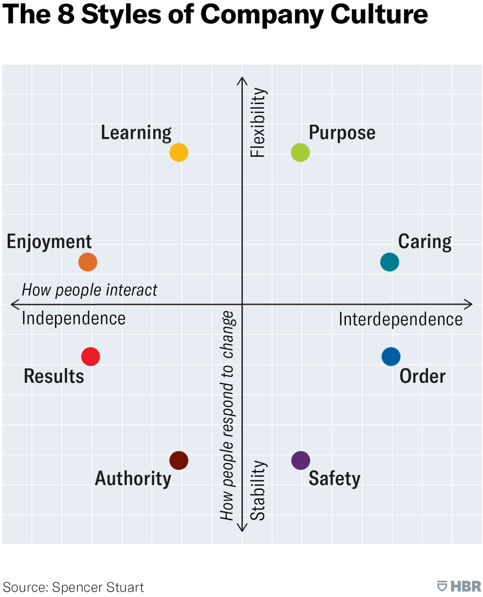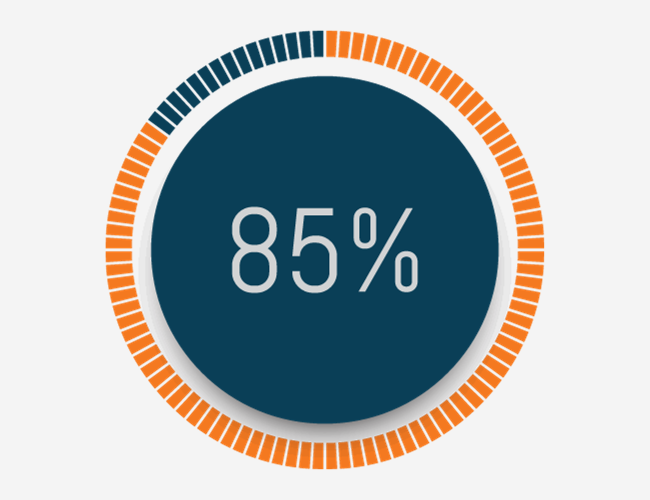The Harvard Business Review (HBR) recently conducted an assessment that looked at how corporate cultures differ across the world. Between December 2017 through May 2019, readers of HBR provided over 12,800 responses about workplace cultures from an organizational (not individual) standpoint. With more than 43% of responses coming from outside of North America, the survey provided an excellent lens with which to examine corporate culture across different regions.
The assessment examined how people respond to change (flexibility vs. stability) and how people interact (independence vs. interdependence). Using these two frameworks, eight “styles” of company culture were identified: (i) purpose, (ii) caring, (iii) order, (iv) safety, (v) authority, (vi) results, (vii) enjoyment, and (viii) learning.

Globally, caring was the most reported style, followed by results, purpose, and learning. This reflects many companies’ emphasis on collaboration and achievement and a general tendency towards interdependence. Enjoyment and authority ranked the lowest. However, a closer look at the data revealed interesting regional patterns and differences.
In Africa, a significant number of workplaces prioritized caring, learning, and purpose, reflecting a tendency towards flexibility and a greater ability to handle change. On the other end of the spectrum, companies in Eastern Europe and the Middle East favored stability. In these areas, workplaces prioritized safety as well as (in the Middle East) authority.
When it came to the way employees interact, the data showed that companies in Western Europe and the Americas tended towards independence. South American companies, especially, ranked enjoyment high, while Western Europe and North America focused on achievement through results and meeting goals. In contrast to this, those in Asia, Australia, and New Zealand were characterized by interdependence, prioritizing caring and safety. Particularly, Asian companies preferred order.
How Company Culture Can Affect Wellness Needs
These differences in company culture, and the potential effects that external environments can have on workplace behaviors, emphasize that there isn’t a one-size-fits-all solution to employer wellness programs. What works for one group may not work for another.
When building an effective wellness program, it’s important to consider the culture of an organization: how people interact and socialize, respond to change, handle work tasks, and set goals. Do people prioritize mental health and self-care or career achievements and financial goals? What are the demographics and backgrounds of employees, and how might this affect their health and overall well-being needs? Additionally, it’s important to note that these behaviors and values can differ between departments, job roles, or other work groups.
For example, some industries have much higher rates of tobacco use. Offering programs for smoking cessation and making engagement in those a priority would be significantly beneficial to productivity. With a largely middle-aged staff, flexible schedules for parenting or caregiving responsibilities might give a boost to overall work performance and mental health. Teams that prefer order and structure might expect more extensive details and descriptions of their available wellness resources.
These cultural insights can also assist in deciding how benefits and programs are structured. Collaborative teams might see better results with programs that involve team interaction and efforts, such as group wellness challenges, team-building social outings, or fitness classes. Independent workers, on the other hand, might be less engaged with such offerings.
Potential Challenges
With the rise of telecommuting and remote work, it may be necessary to take into consideration how employees from regions outside of on-site staff have different cultural styles. Of course, this can be difficult to gauge, and it can also be a challenge to not jump to conclusions based on limited knowledge of regional stereotypes. Obviously, the more employees a company has working remotely, the more significant this consideration becomes.
The implications of regional differences and a more diverse workforce can also come into play when an organization is looking to expand, or when managing global teams. In these cases, having a variety of wellness options that can suit different demographics might be the easiest solution. Later, reviewing what does and doesn’t work for certain teams can give better insight into the particular wellness needs of a group.












